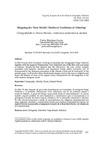Identificador persistente para citar o vincular este elemento:
https://accedacris.ulpgc.es/jspui/handle/10553/25201
| Campo DC | Valor | idioma |
|---|---|---|
| dc.contributor.author | Martínez García, Pedro | en_US |
| dc.date.accessioned | 2018-01-23T03:31:32Z | - |
| dc.date.accessioned | 2018-06-18T06:46:47Z | - |
| dc.date.available | 2018-01-23T03:31:32Z | - |
| dc.date.available | 2018-06-18T06:46:47Z | - |
| dc.date.issued | 2018 | en_US |
| dc.identifier.issn | 1133-598X | en_US |
| dc.identifier.uri | https://accedacris.ulpgc.es/handle/10553/25201 | - |
| dc.description.abstract | In 1562, 70 years after Columbus’s landing in Guanahaní the cartographer Diego Gutiérrez together with the engraver Hieronymus Cock elaborated one of the first scale wall maps of America. Despite the time elapsed since the «Discovery» the «new world» remains populated with fantastic creatures and monstrous beings which eventually will be incorporated to the European perception of the Atlantic world and its backyards. In the present paper, I will present three fundamental images used in this map to enlighten and depict the identity of some of the regions newly incorporated into the imaginary of the early modern European world. | en_US |
| dc.description.abstract | En 1562, 70 años después de que Colón desembarcara en Guanahaní, El cartógrafo Diego Gutiérrez y el grabador Hieronymus Cock elaboraron uno de los primeros mapas a escala de América. A pesar del tiempo transcurrido desde el «descubrimiento» el «nuevo mundo» seguirá poblado de seres fantásticos y monstruosos que se incorporarán a la percepción europea del nuevo espacio atlántico y de su transpatio americano y africano. En este artículo presentaré a modo de microhistorias tres imágenes fundamentales del mapa (gigantes, caníbales y rinocerontes) usadas para ilustrar la identidad de algunas las regiones recién incorporadas al imaginario europeo de la Baja Edad Media y de comienzos de la modernidad. | en_US |
| dc.format | application/pdf | es |
| dc.language | eng | en_US |
| dc.relation.ispartof | Vegueta: Anuario de la Facultad de Geografía e Historia | en_US |
| dc.source | Vegueta : Anuario de la Facultad de Geografía e Historia [ISSN 1133-598X], n. 18, p. 119-131 | en_US |
| dc.subject | 55 Historia | en_US |
| dc.subject.other | Cartography | en_US |
| dc.subject.other | Alterity | en_US |
| dc.subject.other | Travel | en_US |
| dc.subject.other | Atlantic World | en_US |
| dc.subject.other | Cartografía | en_US |
| dc.subject.other | Alteridad | en_US |
| dc.subject.other | Viaje | en_US |
| dc.subject.other | Mundo Atlántico | en_US |
| dc.title | Mapping the ‘New World’: Medieval Traditions of Othering | en_US |
| dc.title.alternative | Cartografiando el «Nuevo Mundo»: tradiciones medievales de otredad | en_US |
| dc.type | info:eu-repo/semantics/article | en_US |
| dc.type | Article | en_US |
| dc.compliance.driver | 1 | es |
| dc.description.lastpage | 131 | en_US |
| dc.description.firstpage | 119 | en_US |
| dc.relation.volume | 18 | en_US |
| dc.investigacion | Artes y Humanidades | en_US |
| dc.rights.accessrights | info:eu-repo/semantics/openAccess | es |
| dc.type2 | Artículo | en_US |
| dc.utils.revision | Sí | en_US |
| dc.identifier.ulpgc | Sí | en_US |
| dc.description.esci | ESCI | |
| dc.description.fecytq | Q3 | |
| dc.description.fecytpuntuacion | 27,85 | |
| dc.description.dialnetimpact | 0,0 | |
| dc.description.dialnetq | Q1 | |
| dc.description.dialnetd | D3 | |
| dc.description.erihplus | ERIH PLUS | |
| item.fulltext | Con texto completo | - |
| item.grantfulltext | open | - |
| Colección: | Artículos Vegueta. n.18, 2018 | |
Visitas
356
actualizado el 13-dic-2025
Descargas
440
actualizado el 13-dic-2025
Google ScholarTM
Verifica
Comparte
Exporta metadatos
Los elementos en ULPGC accedaCRIS están protegidos por derechos de autor con todos los derechos reservados, a menos que se indique lo contrario.
